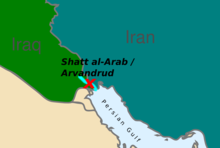Joint Operation Arvand
| Joint Operation Arvand | |||||||
|---|---|---|---|---|---|---|---|
| Part of the Persian Gulf Conflict and the Cold War | |||||||
 Location of the conflict |
|||||||
|
|||||||
| Belligerents | |||||||
|
|
|
||||||
| Commanders and leaders | |||||||
|
|
|
||||||
| Units involved | |||||||
|
Imperial Iranian Navy Imperial Iranian Air Force Imperial Iranian Army |
Iraqi Navy Iraqi Ground Forces |
||||||
| Strength | |||||||
| 2 navy ships and a squadron of F4 Phantom | Thousands of troops | ||||||
| Casualties and losses | |||||||
| None | None | ||||||
Iranian victory
The Joint Operation Arvand (Persian: عملیات مشترک اروند, more known by its Persian acronym AMA, عما) was a show of force operation orchestrated in April 1969 by the Imperial Iranian Armed Forces following Iraqi claim for the sovereign right to Shatt al-Arab/Arvand Rud and threatening to block passage of vessels unless they fly Iraqi flag.
On 22 April 1969, Iranian merchant ship Ebn-e-Sina, carrying a cargo of steel beams and flying Iranian flag, was escorted by Iranian heavily armed naval vessels, as well as jet fighters and proceeded through the river into the Persian Gulf, in a 80-mile journey which took about six hours. However, the Iraqi forces did not attempt to respond as it pledged.
Both countries strengthened their land forces along the river bank, stationing artillery, tanks and anti-aircraft weapons. Iranian troops were positioned in the vicinity of Khorramshahr and Abadan, while Iraq put its forces in Basra on alert.
Iranian freighter Arya Far passed through the river escorted by four gunboats three days later, with no disturbance.
...
Wikipedia
